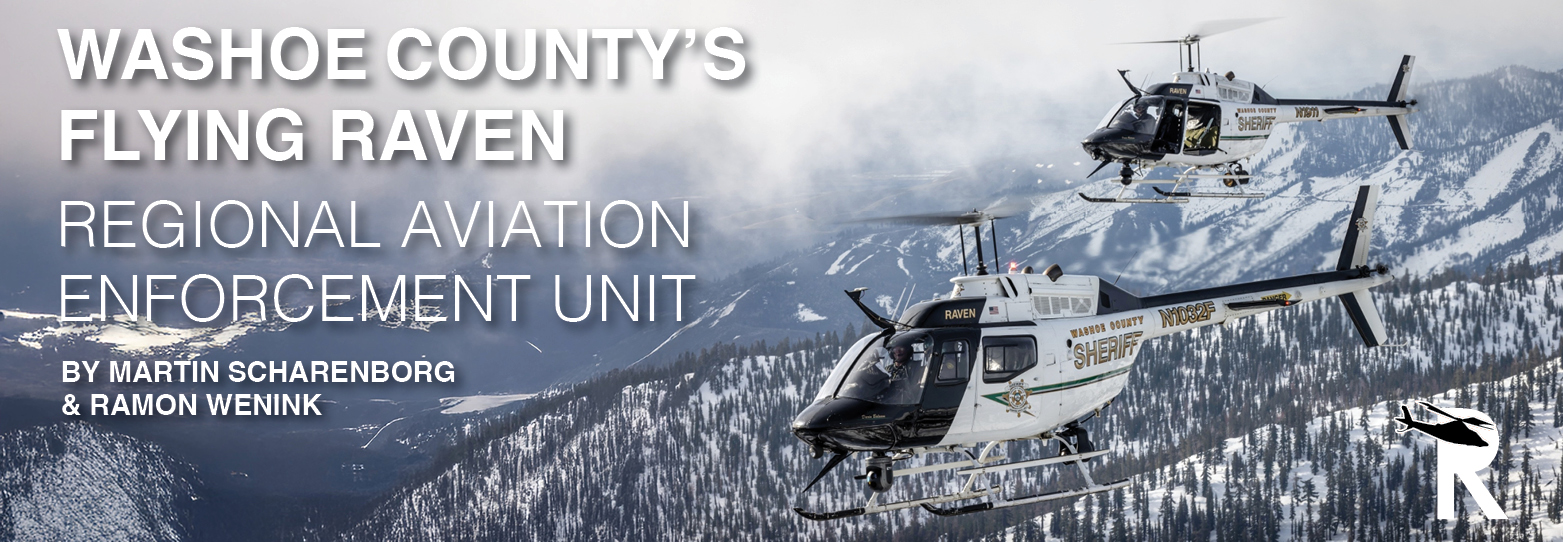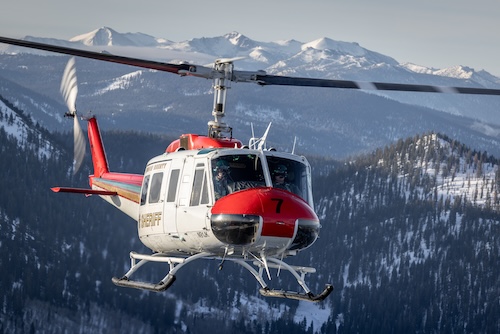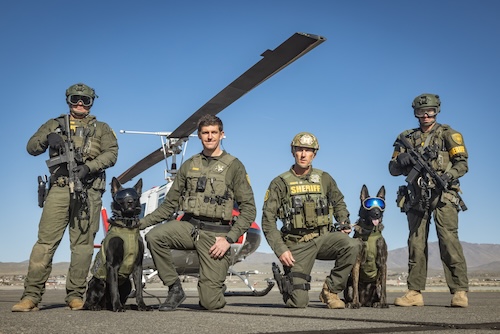|
Aug
18
2025
|
|
Posted 125 days ago ago by Admin
|
|

Covering almost 17,000 square kilometers (10,560 square miles) that includes famous nature reserves such as the Sierra Nevada, Lake Tahoe and pyramid lake, Washoe County is also known for its “Biggest Little City in the World”— Reno. The city is known for its many casinos, but also for the renowned Reno-Air Races and attracts thousands of tourists. Therefore, the Washoe County Sheriff’s Office relies heavily on its airborne law enforcement unit called RAVEN.
The Regional Aviation Enforcement Unit (RAVEN) was established in 1996 when funding became available to set up a dedicated unit to conduct airborne law enforcement, firefighting and search and rescue (SAR). The first two helicopters were officially registered in January 1997, being two former Army Bell OH-58A+ Kiowas (RAVEN 1 and RAVEN 2) and later joined by some Bell UH-1Hs and HH-1Hs of which two are still serving with the unit: RAVEN 3 and RAVEN 7.
“The helicopters are on loan from the military LESO program (Law Enforcement Support Office) This 1033 program (formerly the 1208 program) allows the Secretary of Defense to transfer surplus Department of Defense material to national law enforcement agencies. “We have to maintain these aircraft to military standards in case they have to be returned to the military when phased out of service,” says Deputy Joseph Baumann, RAVEN’s chief pilot. Currently RAVEN has one full-time pilot, three part-time pilots, one full-time mechanic and two part-time mechanics.

Hasty
A special team within the Washoe County Sheriff’s Office is HASTY. Founded in 1971, the team consists of unpaid volunteer professionals who specialize in high- and low-angle rope rescue operations, mine rescues, swift-water rescues, dive rescue and recovery, and underwater remotely operated vehicles (ROVs). “They do deep underwater searches and recently they did the deepest underwater search in Lake Tahoe, which is over 1,500 feet deep,” says Baumann. “They are more a technical type of rescue team. Eight members of that team we are using as hoist specialists and for medical rescues. We also have 10 paramedics in our HASTY team provided by REMSA. So, basically when we have a call out for a rescue, we always have a paramedic on board. It is a huge benefit.”
Mission
“Our other duties besides law enforcement, firefighting and search and rescue are amongst others: performing on-static displays, overwatch during VIP transports, Department of Homeland Security missions, counter drug operations and transporting our HOPE-team, which stands for Homeless Outreach Proactive Engagement. They ask us to search in specific regions to find homeless camps to make a new outreach to see if they need help. RAVEN is very important to Washoe and the surrounding counties. We are the only airborne division in Northern Nevada and California. Any county that is attached to Washoe County, as a friend or as a neighbor, can make a direct request for service or missions .

Sergeant Joshua Fisher, dispatch and liaison officer for RAVEN at Reno-Stead Airport, explains RAVEN’s assistance procedures: “When a call for assistance comes in, it usually goes through dispatch, or another sheriff’s office. The supervisor gives a call to the unit and RAVEN looks at it and vets it. If the sheriff’s office approves the mission, we fire up our incident management team and follow a certain SAR-protocol and we also build a map with the help of CalTopo. It is like a search program; we can have any of the maps on it and they can mark the maps. Not only can they track any of the SAR helicopter personnel, so they can see us, but also the SAR teams on the ground, so you can easily see the areas that you have covered. The guys at IMT (incident management team) can actually put in points last seen , any items that were found, and mark everything they want. I am responsible for that in RAVEN.
“Weather is also very important as winds can be very treacherous on this side of the mountains, but also the visibility is very important. We use anything at our disposal like road cams , ski-hill cameras as well as the weather service. Ultimately, the decision to fly or not-to-fly is up to the pilot. Sometimes we have a mission to a very remote site. We plan our fuel truck to meet us somewhere in the middle to make the specific mission possible. Sometimes it isn’t even necessary to send a helicopter up, but in that case we already sent our Special Vehicle Unit up (SVU). You also always have to plan for a contingency. You depend on your Plan A, but you always have to have a Plan B in case something happens. There is a lot going on in the background to make everything work together,” Fisher concludes.
Challenge, but Capable
Deputy Baumann explains a challenge that faces RAVEN that’s common to many fleets: “The biggest weakness we are running into is that we have older helicopters and we are getting lower on parts.”
However, the helicopters themselves are still very capable. “In comparison with other helicopters, we still have the power to climb up Mount Rose, which is over 9.000 feet. We are able to sit there and hover! Some aircraft can’t do that.” Baumann says. “Our Hueys are modified to the Huey II standard having basically the AH-1 Cobra engine, T12 transmission, Bell Strake Kit, and BLR’s FastFin system. With Raven 3 we also have the composite rotor blades, which gives us another hot-and-high power (aircraft) to operate at higher altitudes during hot weather conditions and it also has the global rotor compensator. Another change is a new tail-rotor kit that moves the rotor from the left side to the right, making it a tractor or puller-style rather than a pusher-style anti-torque system. It gives more power and pull. For the size and the ability, it is sometimes more capable than some of the newer helicopters. However, it is all hands on. We don’t have auto-flight systems like auto-hover. It is not stabilized, so it is quite intensive flying. It is basically a work truck. RAVEN 7 still has the metal-made main-rotor blades with a Bell 212 tail rotor-blade. RAVEN 3 has a Bell 204 rotor-blade with a global compensator. We have more tail rotor authority on Raven 3 than we do with the 212 rotor-blades, although both Hueys have almost the same tail-rotor authority. I have never lost tail-rotor authority when we have been up, even working on higher altitudes, so they both do a good job.

“When we go into the mountains, you have to read the wind because one side of the hill can be different than the other side of the hill. The winds swirl around. We get 100 degrees here and even in the summer we have no problem going into the mountains we have around here up to 14,000 feet. In the summertime, if we have to pick up extra load when people get injured, we watch our tables and check everything before we go to make sure we have enough power to go in and do the hoist. If not, we might have to offload,” Baumann concludes.
Sergeant Fisher says that RAVEN has to sometimes barter to remain fully equipped. “We do some horse trading. We work with other agencies, even regionally here, to kind of swap parts for things that we have a lot of and they would need, and if they have something we need. We do all kinds of stuff to keep the program rolling.”
Teamwork
Baumann explains how coordinated teamwork brings RAVEN together. “In early 2021, we had to fly down to search for a guy, but it turned into a rescue. At one time the rescue teams couldn’t get out anymore as the snowdrifts were so bad. People were stuck. We had tracked vehicles but even they couldn’t get to that location. So I had to get back here at Carson City Airport, switch helicopters, switch roles, get into the Huey, fly down there to hoist them out and fly back to get (our rescued person) medical attention.
“That same day, during lunchtime, another call came in that a snowboarder was stranded at the bottom of a gully. It was very challenging trying to get in there. The winds were not that bad, but it was turbulent and the clouds circled around him. I tried for a long time to get in there, but I had to come down, sit and take a break and then go back up again. The snowboarder went down on the east side of Mount Rose but the way to get to him was going to the south up around the mountain, and come down from the North west to get down into him . We sent down two of our HASTY team skiers and later we picked them and their equipment all up. The snow, the avalanche danger and the low visibility that day was pretty much challenging.

In the end, no one is more important than the other as we have to work together as a team to get the mission done. Most of the time we are operating with one pilot and one TFO. Basically I am the Über-driver to get people into position. I am talking to other aircraft in the air and with air traffic control (ATC), while the TFO is talking to the tactical units on the ground. We can listen to six different radio frequencies at one time. We have a lot that goes on sometimes. If I didn't have a TFO, I couldn’t do the mission. If we didn’t have the HASTY team guys, we wouldn't have enough personnel to do the rescue. That even goes down to the volunteers, dispatchers and the mechanics.”
Small, but big
Raven has proven to be invaluable for Washoe County responding annually to approximately 1.000 calls, divided roughly 75% to SAR and 25% to patrol/law enforcement missions. “We are the only aerial law-enforcement unit in Northern Nevada. Being up in the air, we are kind of a deterrent and withhold people in the area from speeding. Moreover, our RAVEN 3 dropped 29,078 gallons of water in 2023 fighting against wildfires, so we are quite busy for a relatively small unit,” concludes Fisher.
You could say that RAVEN is the Reno region’s “biggest little air unit in the world.”
READ MAY/JUNE ISSUE OF ROTOR PRO
READ MORE ROTOR PRO: https://justhelicopters.com/Magazine
WATCH ROTOR PRO YOUTUBE CHANNEL: https://buff.ly/3Md0T3y
You can also find us on
Instagram - https://www.instagram.com/rotorpro1
Facebook - https://www.facebook.com/rotorpro1
Twitter - https://twitter.com/justhelicopters
LinkedIn - https://www.linkedin.com/company/rotorpro1